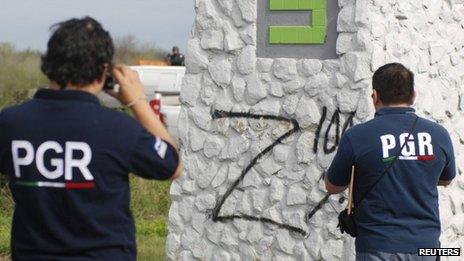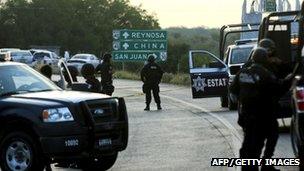Mexico violence: Fear and intimidation
- Published

Drug cartels such as the Zetas boast of their violent exploits to intimidate rival gangs
In September 2006, gunmen opened the doors of the Sol y Sombra discotheque in Uruapan, in the western Mexican state of Michoacan, and threw five human heads onto the dance floor.
As frightened partygoers looked on, the gang left a scrawled message at the scene, announcing the arrival of a new, breakaway drug cartel called La Familia Michoacana, and walked out as coolly as they had entered.
For many, it represented a shocking new degree of brutality by the country's drug traffickers. It made headlines around the world.
Francisco Castellanos is the correspondent for the respected Mexican magazine, Proceso, in Michoacan.
He sees the 2006 beheadings as a game-changing moment in the conflict:
"The five were local drug dealers in Uruapan", he says in an email from the embattled Pacific state, adding that the hastily-written threat left at the crime scene spoke of "divine justice".
"It generated great fear and terror", remembers Mr Castellanos, "and then investors started to leave for more secure areas."
<bold>Coded killings</bold>
"In the 1990s, the cartels didn't cut the heads off their victims", says Samuel Gonzalez Ruiz, a former advisor to the UN Office on Drugs and Crime.
"They used different codes of murder which were more or less established between the criminals," Mr Gonzalez Ruiz says.
He tells of a well-known hitman who sent out messages by the different ways he shot his victims.
A bullet to the back of the head, for example, meant the victim was a traitor, a bullet to the temple signified he was a member of a rival gang.
Now, however, beheading is a tactic often employed by Mexican drug organisations, in particular by the vast criminal network Los Zetas and their two main rivals, the Gulf Cartel and the Sinaloa Cartel.
Such a violent form of execution is generally associated with the sort of radical Islamist groups who killed US journalist Daniel Pearl in Pakistan, or British civil engineer Kenneth Bigley in Iraq.
<bold>Cult of death</bold>
But the Mexican context is very different, says Mr Gonzalez Ruiz. He argues the practice comes from Guatemala:
"In 2000, the Zetas began to extend their reach into Central America, and they incorporated into their ranks members of the elite jungle squad, the Kaibiles."

The cult of La Santa Muerte is on the rise and some see a link to the extreme violence
"The Kaibiles had been trained in using decapitation to threaten the local population since the times of the country's dirty war (1960-1996)."
Others see links to a religious cult popular with the drug gangs called La Santa Muerte, or Holy Death.
Some commentators have even drawn comparisons to pre-Columbian human sacrifices by the Aztec and the Mayan civilisations.
Wherever it stems from, the gruesome practice is now a staple in the lexicon of violence of the drug cartels in Mexico.
This month has been perhaps the worst in terms of decapitations.
In the past 10 days alone, there have been an unprecedented 81 beheaded bodies discovered in the country.
In early May, 14 decapitated bodies were found in Nuevo Laredo, just over the border from Texas.
Last week, 18 bodies and severed heads were left in two mini-vans near Lake Chapala, an area popular with tourists in western Mexico.
Finally, in one of the most shocking incidents of its kind since the current drug war began, 49 headless and mutilated bodies were left in plastic bags on a road outside the industrial city of Monterrey.
<bold>'Intimidating civilians'</bold>
So, beyond the obvious, what are the cartels trying to achieve by butchering their victims in this way?

Mexican police officers blocked the road following the discovery of the 49 bodies in Monterrey
For the government, it was intended as an uncompromising message of fear and intimidation.
These "reprehensible acts" were designed to "sow fear among the civilian population and the authorities", said Interior Minister Alejandro Poire the day after the Monterrey atrocity.
It was the result of a dispute between the Zetas and the Gulf Cartel, the minister said, before repeating the government's offer of a substantial reward for information on the whereabouts of the cartels' leaders.
But for Mr Gonzalez Ruiz, a former State Attorney on Organised Crime, the beheadings also had a clear political dimension.
"The message is clear: we have no mercy, and we will do whatever it takes to control our territory," he says.
' <bold>Terrorist strategy'</bold>
The timing is particularly important, he adds, coming just six weeks before a presidential election in the country.
"It's partly a message to the presidential candidates, most of whom have said they won't negotiate with the drug cartels."
But it also has a wider, more frightening message of intimidation against ordinary people in cities like Monterrey.
Mr Gonzalez Ruiz uses a word the government has been loathe to use in association with the country's drug violence: terrorism.
"You can only call this strategy (of beheading the victims) a terrorist's strategy. It's terrorism because it sends a threat to the population: 'if you don't allow us to control our illegal business, we will do the same to you'."
Thinly veiled messages of intimidation aside, the recent atrocities are a grisly reminder of the extent of the cartels' power in Mexico, and the lengths to which they are prepared to go to hold onto it.